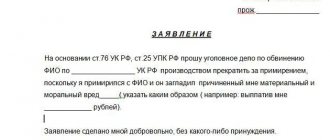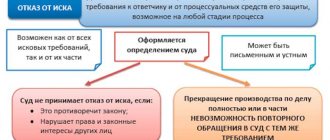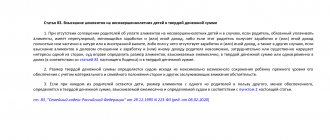Author of the article: Yulia Kaisina Last modified: January 2021 7897
If, after a divorce, one of the spouses does not want to receive financial assistance from the other, he or she has a question: how to withdraw an application for alimony. If a parent wants to refuse child support, the easiest way is not to submit the writ of execution to the bailiff service. When proceedings are already open and money is being withheld, it will be more difficult to stop paying alimony. It is necessary to convince those in charge that this will not infringe on the interests of the child.
Waiver of alimony
Russian legislation does not consider the issue of officially refusing alimony payments. The law states that all actions of parents must not affect the rights of the child.
It happens that one of the parents, due to psychological reasons, refuses to receive child support payments, although their own cash reserve does not contain a large amount of money.
In this case, the guardianship authorities are trying to prove that the child is being kept in unsuitable conditions due to the lack of additional funds allocated for his maintenance. Such a refusal by a parent may result in the deprivation of his parental rights.
Termination of alimony agreement
If an alimony agreement has been concluded between the spouses, it cannot be canceled. You can either not give it a go, or terminate the previous one and enter into a new one, in which the refusal to receive money will be recorded. However, one must keep in mind: if the parties do not support their decision with any compensation, the notary will refuse to certify the document.
Expert commentary
Gorbunova Olga
Lawyer
Such compensation may be a one-time transfer of a large sum of money or expensive property. Also, regular payments in the agreement can be replaced by “in-kind” payments - the purchase of clothes and shoes, payment for clubs and sections, etc. The main thing: the notary must be sure that the parents’ agreement does not infringe on the rights of the child.
Revocation of alimony funds
How to submit an application for alimony and what is needed for this? To request a waiver of alimony for a minor, contact:
- to a notary's office;
- to court;
- to the bailiffs.
The grounds for choosing the method of registration of refusal are:
- stage of the alimony collection process;
- method of collecting funds;
- the presence or absence of a peace agreement between the parties.
Both parties initiate the refusal of alimony payments.
How to refuse alimony
How to submit an application for alimony and what should be taken into account? To revoke a writ of execution or a statement of claim, you need to write a new application for the return of documents.
Collectors most often refuse to receive additional funds for child support in the form of alimony for the following reasons:
- Drawing up a peace agreement with the ex-spouse on voluntary payments;
- In connection with the request of the alimony payer;
- A one-time payment of alimony in exchange for the return of a document.
Bailiffs are not particularly interested in these reasons, so they return documents without problems if all the rules are followed:
- The application is correctly drawn up;
- The plaintiff contacted the FSSP at the place of execution of the claim and left all the documents there for three days until the sheet and document were issued.
This is also important to know:
Child support debt after the death of the debtor: who should pay it and how
Before starting the process of waiving alimony payments, be sure to consult with an experienced lawyer so as not to encounter problems in the future.
Application for refusal before trial
This method is the simplest and most peaceful than all the others, since in order not to have to withdraw the claim, you do not need to file it.
Free legal consultation We will answer your question in 5 minutes!
Ask a Question
In order for this decision to become official, it is confirmed with the help of an alimony agreement between the parties. A sample agreement is provided below.
Free legal consultation
We will answer your question in 5 minutes!
Ask a Question
Refusal of alimony payments, regardless of which party is the initiator of this action, must be competently justified and supported by arguments.
The following is a substitute for alimony payments:
- valuable property;
- a one-time large sum of money;
- payment for studies and additional classes.
Not a single notary office will certify an alimony agreement, which indicates a complete refusal of financial assistance from the payer.
How long is the document valid?
Debt can be collected under a writ of execution within a certain period of time. The legislation defines it as three calendar years. The time spent searching for the debtor, obtaining IP by bailiffs, and more is subtracted from it.
If within 3 years the document has not been submitted to the Federal Bailiff Service, then it no longer has any legal force. In this case, you won’t have to think about how to get a writ of execution for alimony. Despite this, the payer's debt still remains. In this regard, it is possible to file a lawsuit again.
The court finds representatives of the FSSP guilty of inaction if the document was submitted on time, but the collection was not made. In this case, the debt will be transferred from the organization itself to the applicant.
Bailiff's decision
The appeal is considered within five days after the bailiff receives the application. Also at this time, a conclusion is made on the satisfaction of the plaintiff’s demands. Next, the enforcement proceedings of the case are suspended, and a resolution is sent to the recipient. After this entire procedure, alimony funds must be paid by the person voluntarily.
Obtaining a writ of execution
The recipient of alimony payments for a child studying at a higher educational institution is given the necessary form immediately after the bailiff makes his decision on the case. A copy of this resolution is also made. Documents are issued upon a personal visit to the bailiff service, as well as through Russian Post.
What does refusal of alimony promise?
The forced collection of alimony payments will cease. Bailiffs will no longer withdraw funds from the payer's wages.
The recipient has the right to file a new claim and a writ of execution to resume the collection of alimony if he does not have enough of his own funds to support the child. The law does not prohibit taking and submitting an application several times. The main thing is that both parties are informed about the issuance of any resolution.
A writ of execution for alimony payments can be submitted to the FSSP authorities at any time before the child reaches the age of majority or when any other compelling reasons arise for stopping the transfer of alimony funds for maintenance.
If you have written a waiver of claims and withdrawn the application, then an application for renewal of collection can only be carried out if significant circumstances and facts for this arise.
Legal consequences of revocation of a writ of execution
It should be said that revoking the writ of execution does not mean abandoning alimony payments. In this case, the collection of alimony is still carried out, which means that the obligation from the alimony payer is not removed.
This is also important to know:
How to get child support if the father is in prison and what needs to be done for this
To revoke a writ of execution is simply to replace the forced collection of alimony payments with a voluntary one.
With voluntary collection, alimony funds are paid in the same amount, with the same dynamics and frequency, as with forced collection. Payment reductions are not permitted.
The payer's debt does not increase if the recipient revokes the writ of execution. This means that if the alimony payer refuses voluntary payments, the amount of alimony debt will not increase.
At any time, the recipient of alimony funds has the right to apply to the SSP with the same writ of execution a second time. From the date of filing the relevant application, the judicial proceedings will be started again.
In this court proceeding, current alimony payments and arrears will be forcibly collected.
The law provided for the possibility of collecting alimony for the period when the writ of execution was revoked.
If the recipient of alimony funds provides evidence that the payer did not voluntarily pay the sums of money, then the bailiffs will calculate the amount of the debt (for a period of no more than 3 years). If funds were transferred from the payer, collection of alimony will begin only from the moment the enforcement proceedings are resumed.
How to pick up an application from the accounting department
Sometimes the claimant does not contact the bailiff service, but takes the writ of execution to the accounting department at the defendant’s place of work in person. In this case, it is enough to write an application for the return of the document addressed to the head of the organization. Only the recipient can do this; the payer will need to obtain permission through the court. But this requires legal grounds: for example, the child moved to live with him or was adopted by the mother’s new husband.
Expert commentary
Kamensky Yuri
Lawyer
Sometimes accounting employees refuse to return the writ of execution, citing the fact that only the bailiff can revoke it. But if there was no appeal to the FSSP, then there is no enforcement proceedings. Thus, the bailiffs have no relation to the issued document. The claimant may refer to clause 1 of Art. 46 of the Law “On Enforcement Proceedings”, according to which he has the right to revoke the document. If the accounting department refuses to return it, this decision can be challenged in court.
clause 1 art. 46 of the Law “On Enforcement Proceedings” - Return of the writ of execution to the claimant after the initiation of enforcement proceedings
The writ of execution, according to which the recovery was not carried out or was made partially, is returned to the claimant:
- at the request of the claimant;
- if it is impossible to execute an executive document obliging the debtor to perform certain actions (refrain from performing certain actions), the possibility of execution of which has not been lost;
- if it is impossible to establish the location of the debtor, his property or obtain information about the availability of funds and other valuables belonging to him, located in accounts, deposits or deposited in banks or other credit organizations, except for cases when this Federal Law provides for the search for the debtor or his property;
- if the debtor does not have any property that can be foreclosed on, and all measures taken by the bailiff, permitted by law, to find his property were unsuccessful;
- if the claimant refused to retain the debtor’s property that was not forcibly sold during the execution of the writ of execution;
- if the claimant, by his actions, prevents the execution of the writ of execution.
Who can be the initiator
The recipient of alimony payments or his official representative has the right to withdraw the application for forced collection.
If the recipient himself does not have the opportunity to represent his interests, for example, if he has not reached the age of majority, then his rights are represented by a trusted representative (parent, guardian, trustee).
If a citizen is able to defend his rights, but does not want to do this on his own, then he has the right to transfer these powers to any other authorized person. To transfer powers, a special power of attorney is drawn up between the parties with the help of a notary.
Can they refuse?
Reapply for alimony: is it possible to do this and how to correctly draw up an application for receiving it Alimony can be collected for minor children in marriage or divorce , and also if the persons did not marry, but paternity was established by the court or the spouse’s children were adopted. The assignment of alimony may be accepted: Or when the assignment of alimony as a percentage of wages does not justify itself due to the fact that the husband works irregularly and earnings are below the established minimum. In these cases , she can re-apply for the accrual of maintenance in a fixed amount . Such actions are possible, since in this case the writ of execution is replaced due to a change in the nature of payments.
If alimony was previously assigned and then canceled at the initiative of the recipient, its receipt can be restored by returning the writ of execution to the proceedings by writing an application to the territorial body of the SSP. If the conditions or amount of payments received change, you need to file a lawsuit.
Refusal of child support payments in the absence of consent from the second parent
After filing a claim, the refusal of child support payments can be formalized and submitted to the judicial authorities along with all the necessary evidence. Is it possible to withdraw an application for alimony if one of the parties categorically disagrees with it?
To understand the process better, consider practical situations:
Situation 1 . The plaintiff must provide evidence that the child is not an adult, but does not lack funds for his maintenance, since he now lives with a parent who is obliged to pay child support for him by law.
Example 2 . A person who is unable to make alimony payments due to a difficult financial situation, illness or disability must provide appropriate documents to confirm this fact.
Example 3. If the payer is able to provide evidence that the recipient does not have a legal right to alimony, since he is deprived of parental rights, is incompetent, is addicted to drugs, suffers from alcoholism, etc.








